Strategic Consultancy Report: Marks & Spencer Entrepreneurial Strategy
VerifiedAdded on 2023/01/09
|12
|3589
|69
Report
AI Summary
This report provides a comprehensive analysis of Marks & Spencer's entrepreneurial strategy. It begins with an introduction outlining the scope and objectives, followed by a detailed situational analysis using PESTLE and SWOT frameworks to assess the macro and micro environments. The report then explores strategic choices using Ansoff's growth vector matrix and Porter's generic strategies, evaluating market penetration, product development, market development, diversification, and cost leadership strategies. The analysis culminates in a set of actionable recommendations for Marks & Spencer, based on the findings of the situational analysis and strategic choices, to achieve their goal of increasing sales by 10% in the next year. The report concludes with a summary of the key findings and recommendations.
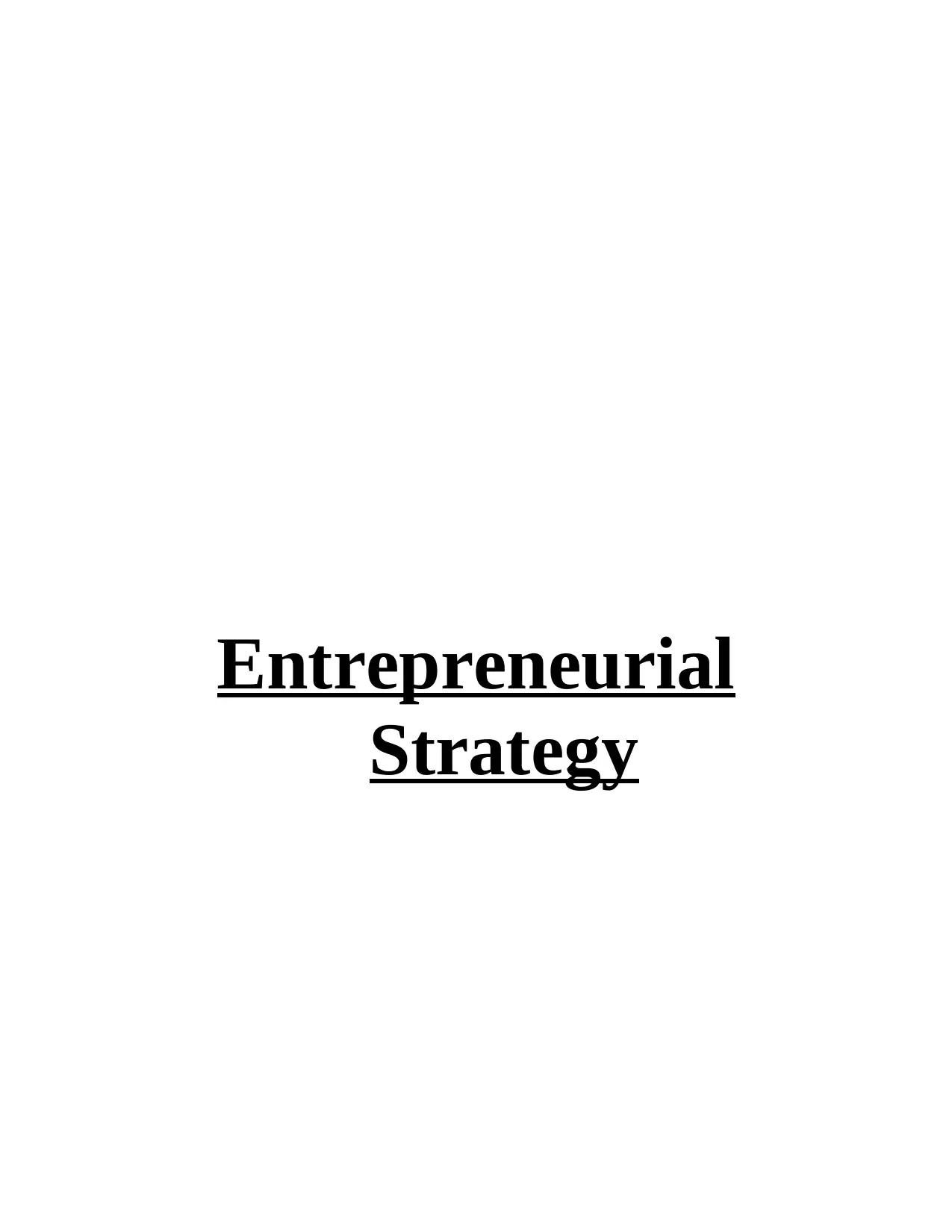
Entrepreneurial
Strategy
Strategy
Paraphrase This Document
Need a fresh take? Get an instant paraphrase of this document with our AI Paraphraser
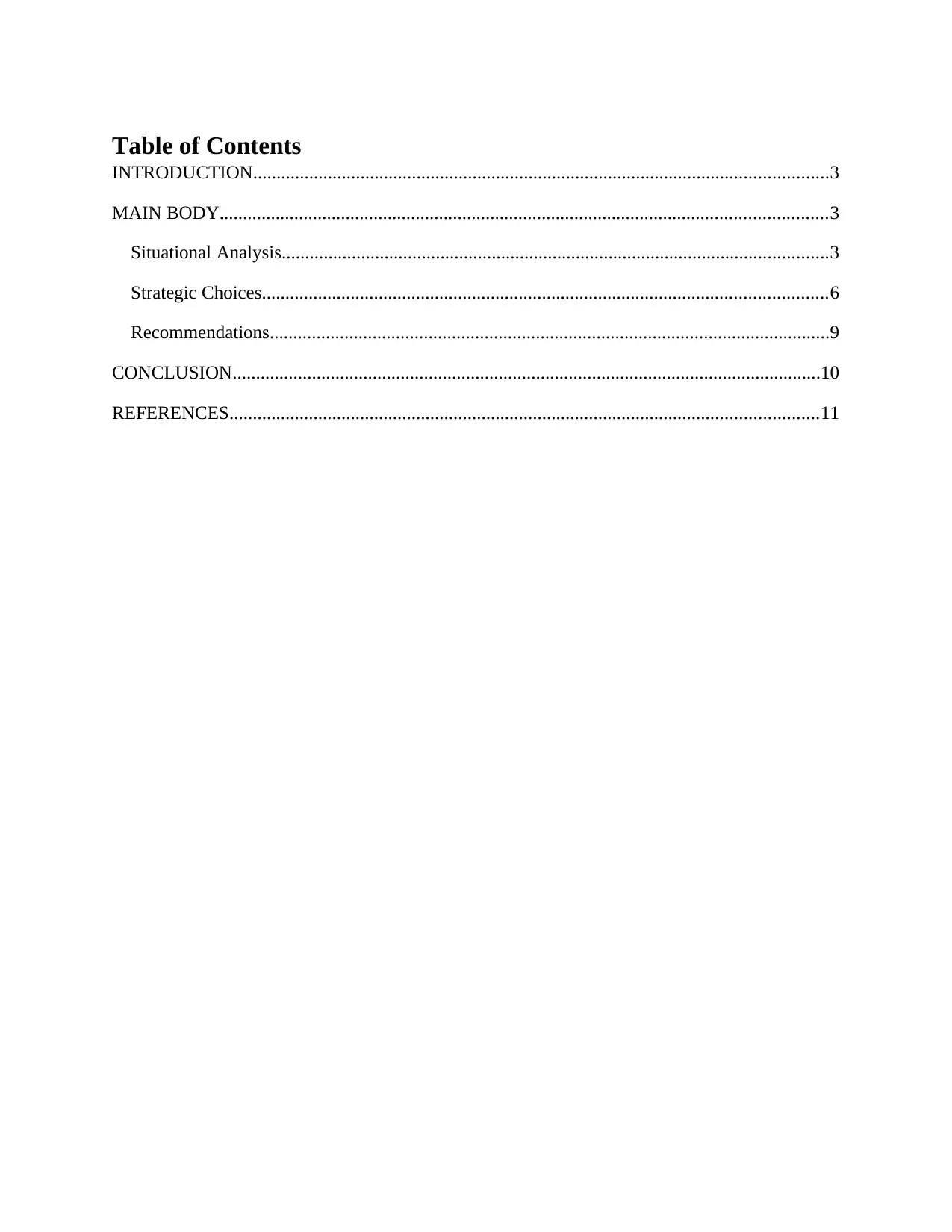
Table of Contents
INTRODUCTION...........................................................................................................................3
MAIN BODY..................................................................................................................................3
Situational Analysis.....................................................................................................................3
Strategic Choices.........................................................................................................................6
Recommendations........................................................................................................................9
CONCLUSION..............................................................................................................................10
REFERENCES..............................................................................................................................11
INTRODUCTION...........................................................................................................................3
MAIN BODY..................................................................................................................................3
Situational Analysis.....................................................................................................................3
Strategic Choices.........................................................................................................................6
Recommendations........................................................................................................................9
CONCLUSION..............................................................................................................................10
REFERENCES..............................................................................................................................11
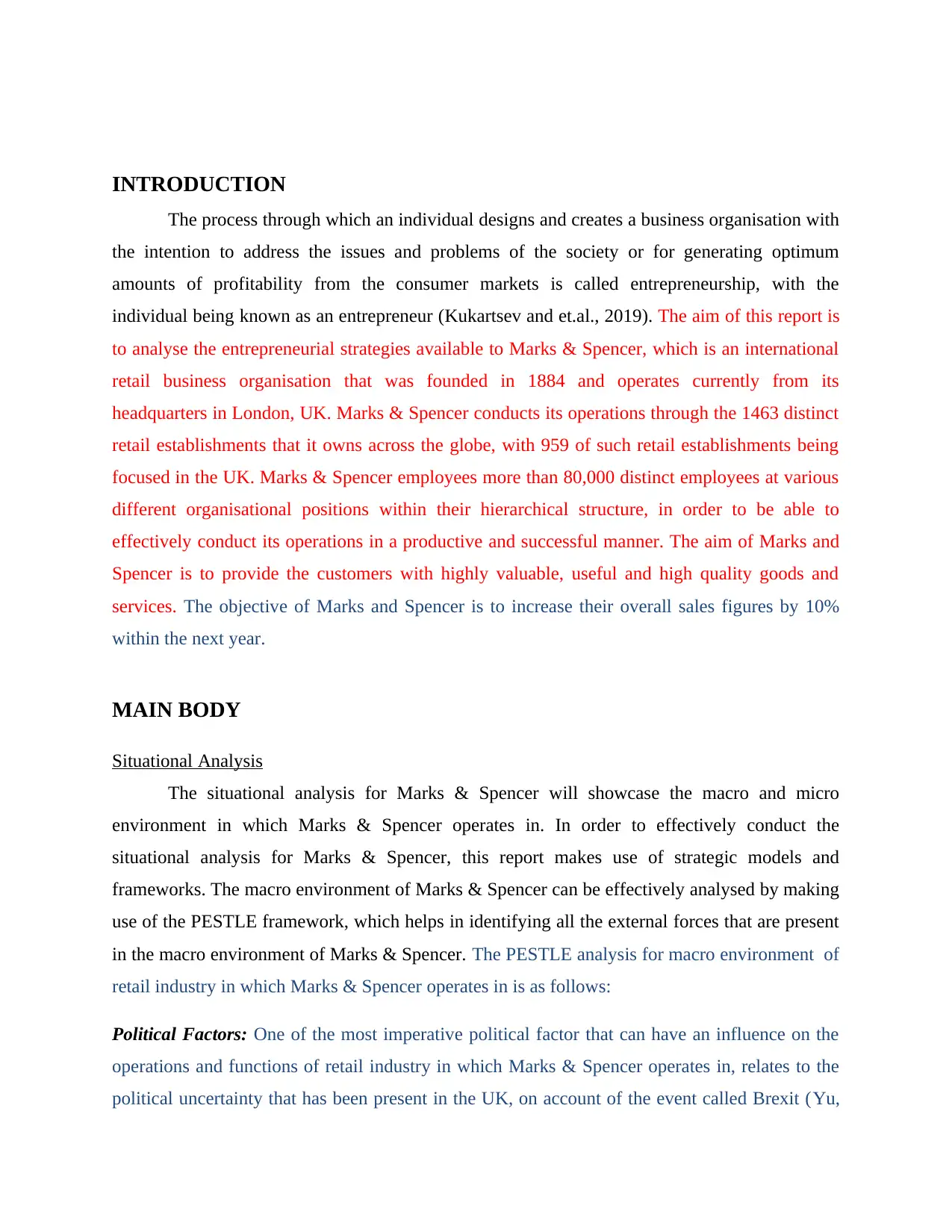
INTRODUCTION
The process through which an individual designs and creates a business organisation with
the intention to address the issues and problems of the society or for generating optimum
amounts of profitability from the consumer markets is called entrepreneurship, with the
individual being known as an entrepreneur (Kukartsev and et.al., 2019). The aim of this report is
to analyse the entrepreneurial strategies available to Marks & Spencer, which is an international
retail business organisation that was founded in 1884 and operates currently from its
headquarters in London, UK. Marks & Spencer conducts its operations through the 1463 distinct
retail establishments that it owns across the globe, with 959 of such retail establishments being
focused in the UK. Marks & Spencer employees more than 80,000 distinct employees at various
different organisational positions within their hierarchical structure, in order to be able to
effectively conduct its operations in a productive and successful manner. The aim of Marks and
Spencer is to provide the customers with highly valuable, useful and high quality goods and
services. The objective of Marks and Spencer is to increase their overall sales figures by 10%
within the next year.
MAIN BODY
Situational Analysis
The situational analysis for Marks & Spencer will showcase the macro and micro
environment in which Marks & Spencer operates in. In order to effectively conduct the
situational analysis for Marks & Spencer, this report makes use of strategic models and
frameworks. The macro environment of Marks & Spencer can be effectively analysed by making
use of the PESTLE framework, which helps in identifying all the external forces that are present
in the macro environment of Marks & Spencer. The PESTLE analysis for macro environment of
retail industry in which Marks & Spencer operates in is as follows:
Political Factors: One of the most imperative political factor that can have an influence on the
operations and functions of retail industry in which Marks & Spencer operates in, relates to the
political uncertainty that has been present in the UK, on account of the event called Brexit (Yu,
The process through which an individual designs and creates a business organisation with
the intention to address the issues and problems of the society or for generating optimum
amounts of profitability from the consumer markets is called entrepreneurship, with the
individual being known as an entrepreneur (Kukartsev and et.al., 2019). The aim of this report is
to analyse the entrepreneurial strategies available to Marks & Spencer, which is an international
retail business organisation that was founded in 1884 and operates currently from its
headquarters in London, UK. Marks & Spencer conducts its operations through the 1463 distinct
retail establishments that it owns across the globe, with 959 of such retail establishments being
focused in the UK. Marks & Spencer employees more than 80,000 distinct employees at various
different organisational positions within their hierarchical structure, in order to be able to
effectively conduct its operations in a productive and successful manner. The aim of Marks and
Spencer is to provide the customers with highly valuable, useful and high quality goods and
services. The objective of Marks and Spencer is to increase their overall sales figures by 10%
within the next year.
MAIN BODY
Situational Analysis
The situational analysis for Marks & Spencer will showcase the macro and micro
environment in which Marks & Spencer operates in. In order to effectively conduct the
situational analysis for Marks & Spencer, this report makes use of strategic models and
frameworks. The macro environment of Marks & Spencer can be effectively analysed by making
use of the PESTLE framework, which helps in identifying all the external forces that are present
in the macro environment of Marks & Spencer. The PESTLE analysis for macro environment of
retail industry in which Marks & Spencer operates in is as follows:
Political Factors: One of the most imperative political factor that can have an influence on the
operations and functions of retail industry in which Marks & Spencer operates in, relates to the
political uncertainty that has been present in the UK, on account of the event called Brexit (Yu,
⊘ This is a preview!⊘
Do you want full access?
Subscribe today to unlock all pages.

Trusted by 1+ million students worldwide
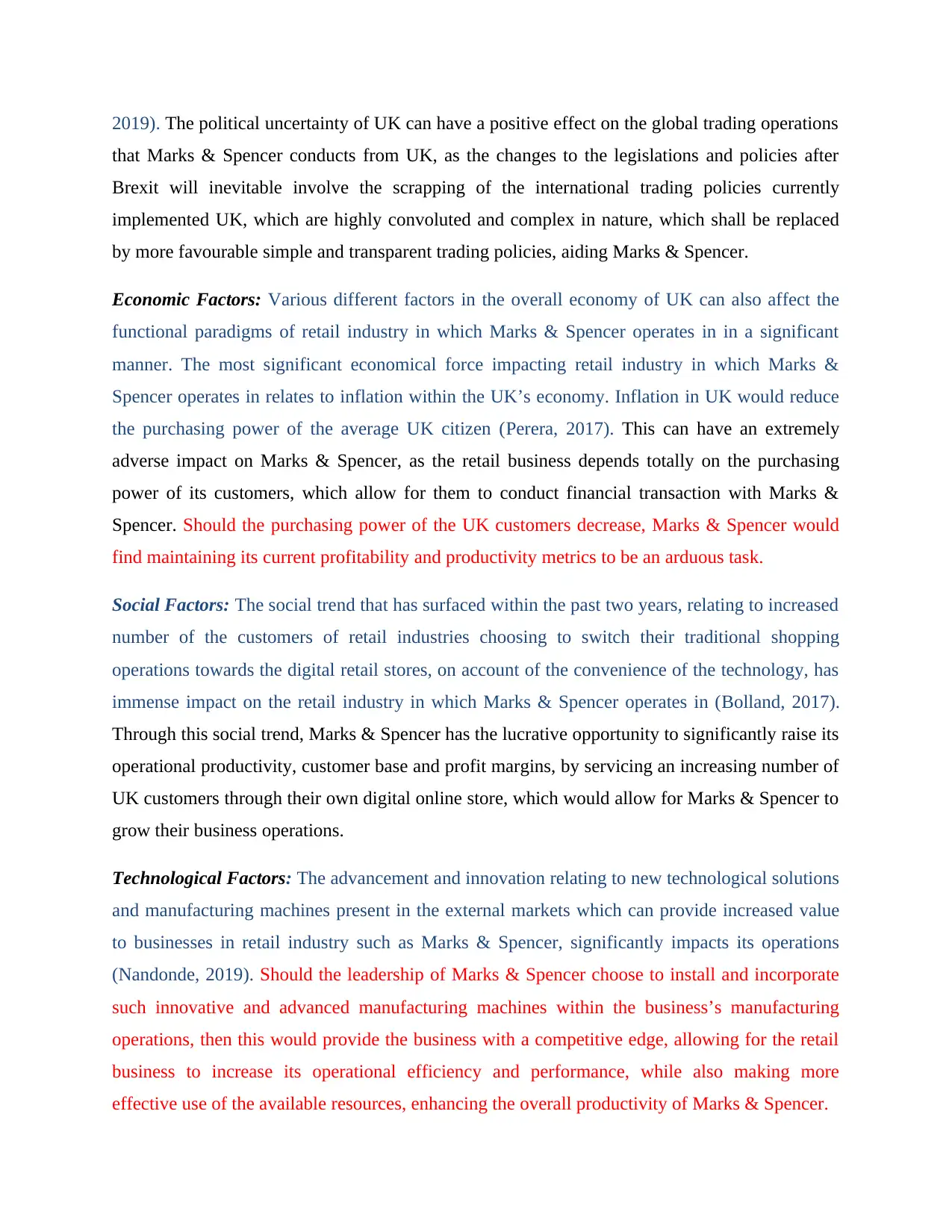
2019). The political uncertainty of UK can have a positive effect on the global trading operations
that Marks & Spencer conducts from UK, as the changes to the legislations and policies after
Brexit will inevitable involve the scrapping of the international trading policies currently
implemented UK, which are highly convoluted and complex in nature, which shall be replaced
by more favourable simple and transparent trading policies, aiding Marks & Spencer.
Economic Factors: Various different factors in the overall economy of UK can also affect the
functional paradigms of retail industry in which Marks & Spencer operates in in a significant
manner. The most significant economical force impacting retail industry in which Marks &
Spencer operates in relates to inflation within the UK’s economy. Inflation in UK would reduce
the purchasing power of the average UK citizen (Perera, 2017). This can have an extremely
adverse impact on Marks & Spencer, as the retail business depends totally on the purchasing
power of its customers, which allow for them to conduct financial transaction with Marks &
Spencer. Should the purchasing power of the UK customers decrease, Marks & Spencer would
find maintaining its current profitability and productivity metrics to be an arduous task.
Social Factors: The social trend that has surfaced within the past two years, relating to increased
number of the customers of retail industries choosing to switch their traditional shopping
operations towards the digital retail stores, on account of the convenience of the technology, has
immense impact on the retail industry in which Marks & Spencer operates in (Bolland, 2017).
Through this social trend, Marks & Spencer has the lucrative opportunity to significantly raise its
operational productivity, customer base and profit margins, by servicing an increasing number of
UK customers through their own digital online store, which would allow for Marks & Spencer to
grow their business operations.
Technological Factors: The advancement and innovation relating to new technological solutions
and manufacturing machines present in the external markets which can provide increased value
to businesses in retail industry such as Marks & Spencer, significantly impacts its operations
(Nandonde, 2019). Should the leadership of Marks & Spencer choose to install and incorporate
such innovative and advanced manufacturing machines within the business’s manufacturing
operations, then this would provide the business with a competitive edge, allowing for the retail
business to increase its operational efficiency and performance, while also making more
effective use of the available resources, enhancing the overall productivity of Marks & Spencer.
that Marks & Spencer conducts from UK, as the changes to the legislations and policies after
Brexit will inevitable involve the scrapping of the international trading policies currently
implemented UK, which are highly convoluted and complex in nature, which shall be replaced
by more favourable simple and transparent trading policies, aiding Marks & Spencer.
Economic Factors: Various different factors in the overall economy of UK can also affect the
functional paradigms of retail industry in which Marks & Spencer operates in in a significant
manner. The most significant economical force impacting retail industry in which Marks &
Spencer operates in relates to inflation within the UK’s economy. Inflation in UK would reduce
the purchasing power of the average UK citizen (Perera, 2017). This can have an extremely
adverse impact on Marks & Spencer, as the retail business depends totally on the purchasing
power of its customers, which allow for them to conduct financial transaction with Marks &
Spencer. Should the purchasing power of the UK customers decrease, Marks & Spencer would
find maintaining its current profitability and productivity metrics to be an arduous task.
Social Factors: The social trend that has surfaced within the past two years, relating to increased
number of the customers of retail industries choosing to switch their traditional shopping
operations towards the digital retail stores, on account of the convenience of the technology, has
immense impact on the retail industry in which Marks & Spencer operates in (Bolland, 2017).
Through this social trend, Marks & Spencer has the lucrative opportunity to significantly raise its
operational productivity, customer base and profit margins, by servicing an increasing number of
UK customers through their own digital online store, which would allow for Marks & Spencer to
grow their business operations.
Technological Factors: The advancement and innovation relating to new technological solutions
and manufacturing machines present in the external markets which can provide increased value
to businesses in retail industry such as Marks & Spencer, significantly impacts its operations
(Nandonde, 2019). Should the leadership of Marks & Spencer choose to install and incorporate
such innovative and advanced manufacturing machines within the business’s manufacturing
operations, then this would provide the business with a competitive edge, allowing for the retail
business to increase its operational efficiency and performance, while also making more
effective use of the available resources, enhancing the overall productivity of Marks & Spencer.
Paraphrase This Document
Need a fresh take? Get an instant paraphrase of this document with our AI Paraphraser
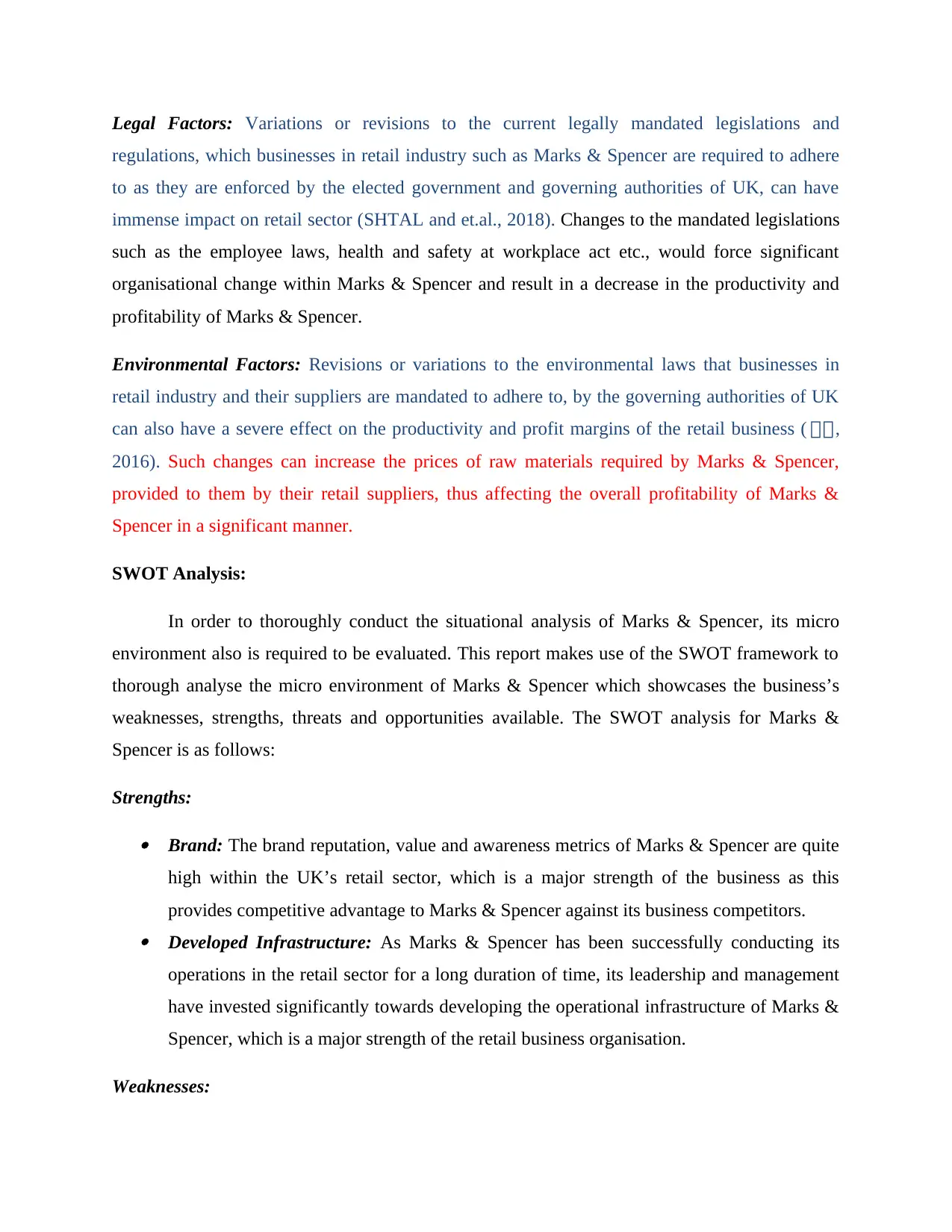
Legal Factors: Variations or revisions to the current legally mandated legislations and
regulations, which businesses in retail industry such as Marks & Spencer are required to adhere
to as they are enforced by the elected government and governing authorities of UK, can have
immense impact on retail sector (SHTAL and et.al., 2018). Changes to the mandated legislations
such as the employee laws, health and safety at workplace act etc., would force significant
organisational change within Marks & Spencer and result in a decrease in the productivity and
profitability of Marks & Spencer.
Environmental Factors: Revisions or variations to the environmental laws that businesses in
retail industry and their suppliers are mandated to adhere to, by the governing authorities of UK
can also have a severe effect on the productivity and profit margins of the retail business ( 杨杨,
2016). Such changes can increase the prices of raw materials required by Marks & Spencer,
provided to them by their retail suppliers, thus affecting the overall profitability of Marks &
Spencer in a significant manner.
SWOT Analysis:
In order to thoroughly conduct the situational analysis of Marks & Spencer, its micro
environment also is required to be evaluated. This report makes use of the SWOT framework to
thorough analyse the micro environment of Marks & Spencer which showcases the business’s
weaknesses, strengths, threats and opportunities available. The SWOT analysis for Marks &
Spencer is as follows:
Strengths:
Brand: The brand reputation, value and awareness metrics of Marks & Spencer are quite
high within the UK’s retail sector, which is a major strength of the business as this
provides competitive advantage to Marks & Spencer against its business competitors. Developed Infrastructure: As Marks & Spencer has been successfully conducting its
operations in the retail sector for a long duration of time, its leadership and management
have invested significantly towards developing the operational infrastructure of Marks &
Spencer, which is a major strength of the retail business organisation.
Weaknesses:
regulations, which businesses in retail industry such as Marks & Spencer are required to adhere
to as they are enforced by the elected government and governing authorities of UK, can have
immense impact on retail sector (SHTAL and et.al., 2018). Changes to the mandated legislations
such as the employee laws, health and safety at workplace act etc., would force significant
organisational change within Marks & Spencer and result in a decrease in the productivity and
profitability of Marks & Spencer.
Environmental Factors: Revisions or variations to the environmental laws that businesses in
retail industry and their suppliers are mandated to adhere to, by the governing authorities of UK
can also have a severe effect on the productivity and profit margins of the retail business ( 杨杨,
2016). Such changes can increase the prices of raw materials required by Marks & Spencer,
provided to them by their retail suppliers, thus affecting the overall profitability of Marks &
Spencer in a significant manner.
SWOT Analysis:
In order to thoroughly conduct the situational analysis of Marks & Spencer, its micro
environment also is required to be evaluated. This report makes use of the SWOT framework to
thorough analyse the micro environment of Marks & Spencer which showcases the business’s
weaknesses, strengths, threats and opportunities available. The SWOT analysis for Marks &
Spencer is as follows:
Strengths:
Brand: The brand reputation, value and awareness metrics of Marks & Spencer are quite
high within the UK’s retail sector, which is a major strength of the business as this
provides competitive advantage to Marks & Spencer against its business competitors. Developed Infrastructure: As Marks & Spencer has been successfully conducting its
operations in the retail sector for a long duration of time, its leadership and management
have invested significantly towards developing the operational infrastructure of Marks &
Spencer, which is a major strength of the retail business organisation.
Weaknesses:
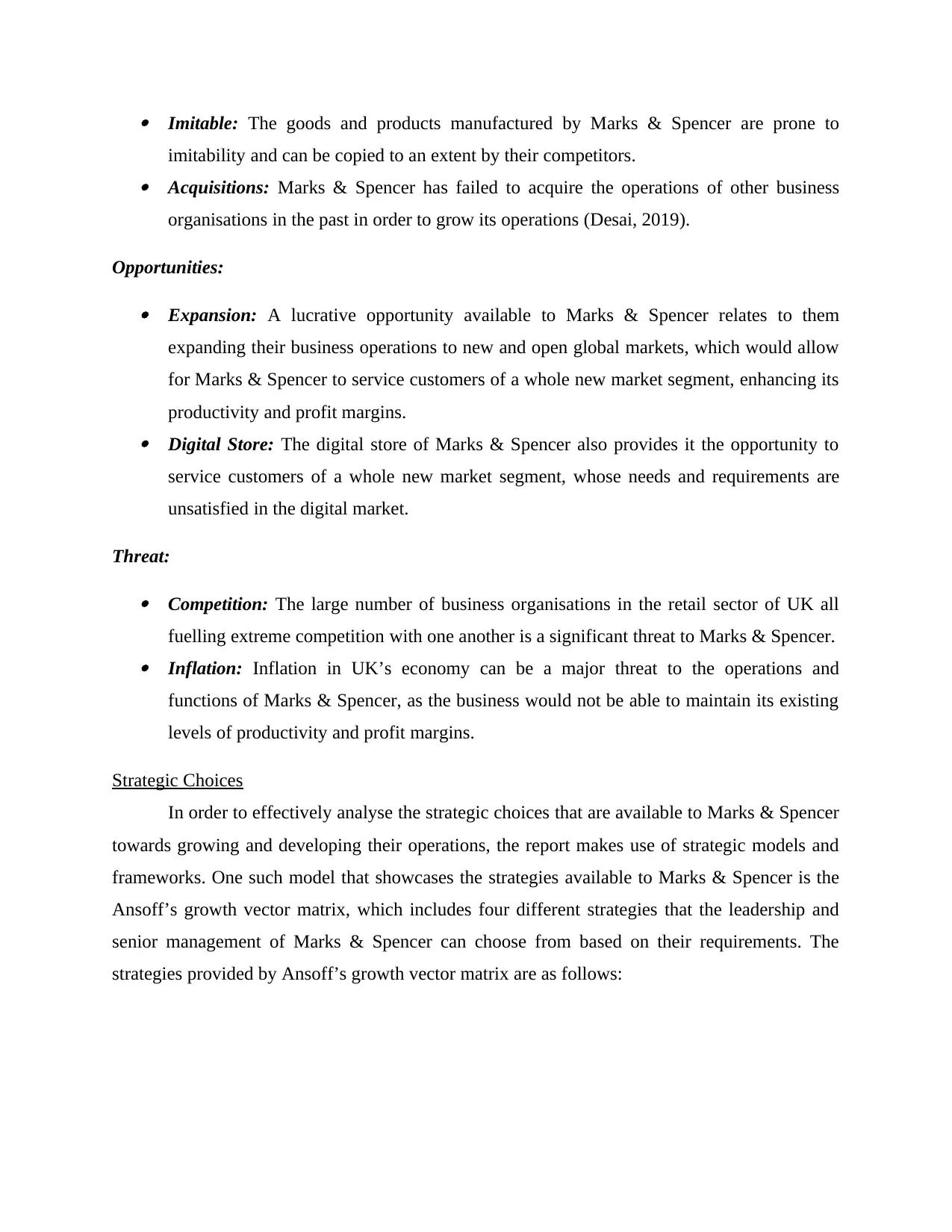
Imitable: The goods and products manufactured by Marks & Spencer are prone to
imitability and can be copied to an extent by their competitors. Acquisitions: Marks & Spencer has failed to acquire the operations of other business
organisations in the past in order to grow its operations (Desai, 2019).
Opportunities:
Expansion: A lucrative opportunity available to Marks & Spencer relates to them
expanding their business operations to new and open global markets, which would allow
for Marks & Spencer to service customers of a whole new market segment, enhancing its
productivity and profit margins. Digital Store: The digital store of Marks & Spencer also provides it the opportunity to
service customers of a whole new market segment, whose needs and requirements are
unsatisfied in the digital market.
Threat:
Competition: The large number of business organisations in the retail sector of UK all
fuelling extreme competition with one another is a significant threat to Marks & Spencer. Inflation: Inflation in UK’s economy can be a major threat to the operations and
functions of Marks & Spencer, as the business would not be able to maintain its existing
levels of productivity and profit margins.
Strategic Choices
In order to effectively analyse the strategic choices that are available to Marks & Spencer
towards growing and developing their operations, the report makes use of strategic models and
frameworks. One such model that showcases the strategies available to Marks & Spencer is the
Ansoff’s growth vector matrix, which includes four different strategies that the leadership and
senior management of Marks & Spencer can choose from based on their requirements. The
strategies provided by Ansoff’s growth vector matrix are as follows:
imitability and can be copied to an extent by their competitors. Acquisitions: Marks & Spencer has failed to acquire the operations of other business
organisations in the past in order to grow its operations (Desai, 2019).
Opportunities:
Expansion: A lucrative opportunity available to Marks & Spencer relates to them
expanding their business operations to new and open global markets, which would allow
for Marks & Spencer to service customers of a whole new market segment, enhancing its
productivity and profit margins. Digital Store: The digital store of Marks & Spencer also provides it the opportunity to
service customers of a whole new market segment, whose needs and requirements are
unsatisfied in the digital market.
Threat:
Competition: The large number of business organisations in the retail sector of UK all
fuelling extreme competition with one another is a significant threat to Marks & Spencer. Inflation: Inflation in UK’s economy can be a major threat to the operations and
functions of Marks & Spencer, as the business would not be able to maintain its existing
levels of productivity and profit margins.
Strategic Choices
In order to effectively analyse the strategic choices that are available to Marks & Spencer
towards growing and developing their operations, the report makes use of strategic models and
frameworks. One such model that showcases the strategies available to Marks & Spencer is the
Ansoff’s growth vector matrix, which includes four different strategies that the leadership and
senior management of Marks & Spencer can choose from based on their requirements. The
strategies provided by Ansoff’s growth vector matrix are as follows:
⊘ This is a preview!⊘
Do you want full access?
Subscribe today to unlock all pages.

Trusted by 1+ million students worldwide
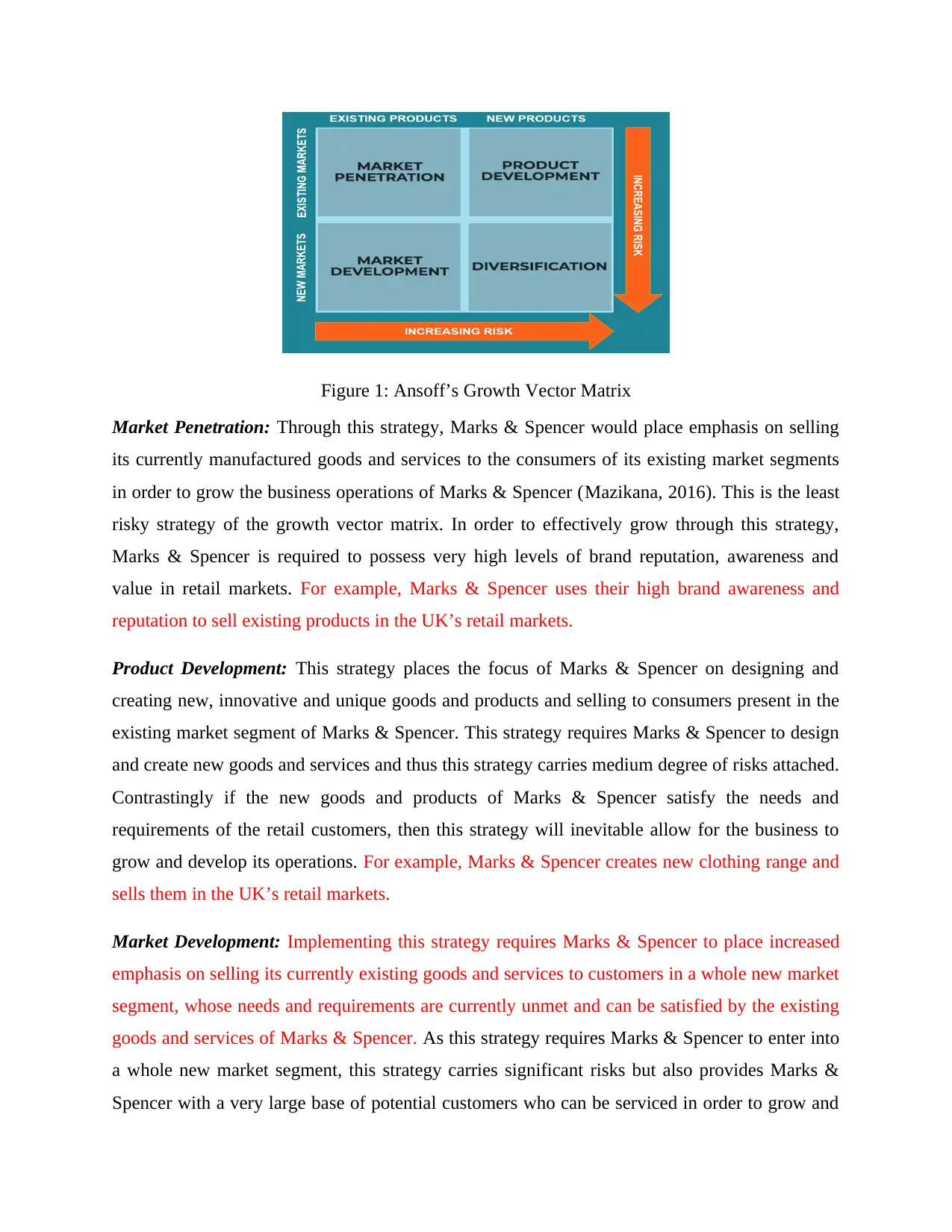
Figure 1: Ansoff’s Growth Vector Matrix
Market Penetration: Through this strategy, Marks & Spencer would place emphasis on selling
its currently manufactured goods and services to the consumers of its existing market segments
in order to grow the business operations of Marks & Spencer (Mazikana, 2016). This is the least
risky strategy of the growth vector matrix. In order to effectively grow through this strategy,
Marks & Spencer is required to possess very high levels of brand reputation, awareness and
value in retail markets. For example, Marks & Spencer uses their high brand awareness and
reputation to sell existing products in the UK’s retail markets.
Product Development: This strategy places the focus of Marks & Spencer on designing and
creating new, innovative and unique goods and products and selling to consumers present in the
existing market segment of Marks & Spencer. This strategy requires Marks & Spencer to design
and create new goods and services and thus this strategy carries medium degree of risks attached.
Contrastingly if the new goods and products of Marks & Spencer satisfy the needs and
requirements of the retail customers, then this strategy will inevitable allow for the business to
grow and develop its operations. For example, Marks & Spencer creates new clothing range and
sells them in the UK’s retail markets.
Market Development: Implementing this strategy requires Marks & Spencer to place increased
emphasis on selling its currently existing goods and services to customers in a whole new market
segment, whose needs and requirements are currently unmet and can be satisfied by the existing
goods and services of Marks & Spencer. As this strategy requires Marks & Spencer to enter into
a whole new market segment, this strategy carries significant risks but also provides Marks &
Spencer with a very large base of potential customers who can be serviced in order to grow and
Market Penetration: Through this strategy, Marks & Spencer would place emphasis on selling
its currently manufactured goods and services to the consumers of its existing market segments
in order to grow the business operations of Marks & Spencer (Mazikana, 2016). This is the least
risky strategy of the growth vector matrix. In order to effectively grow through this strategy,
Marks & Spencer is required to possess very high levels of brand reputation, awareness and
value in retail markets. For example, Marks & Spencer uses their high brand awareness and
reputation to sell existing products in the UK’s retail markets.
Product Development: This strategy places the focus of Marks & Spencer on designing and
creating new, innovative and unique goods and products and selling to consumers present in the
existing market segment of Marks & Spencer. This strategy requires Marks & Spencer to design
and create new goods and services and thus this strategy carries medium degree of risks attached.
Contrastingly if the new goods and products of Marks & Spencer satisfy the needs and
requirements of the retail customers, then this strategy will inevitable allow for the business to
grow and develop its operations. For example, Marks & Spencer creates new clothing range and
sells them in the UK’s retail markets.
Market Development: Implementing this strategy requires Marks & Spencer to place increased
emphasis on selling its currently existing goods and services to customers in a whole new market
segment, whose needs and requirements are currently unmet and can be satisfied by the existing
goods and services of Marks & Spencer. As this strategy requires Marks & Spencer to enter into
a whole new market segment, this strategy carries significant risks but also provides Marks &
Spencer with a very large base of potential customers who can be serviced in order to grow and
Paraphrase This Document
Need a fresh take? Get an instant paraphrase of this document with our AI Paraphraser
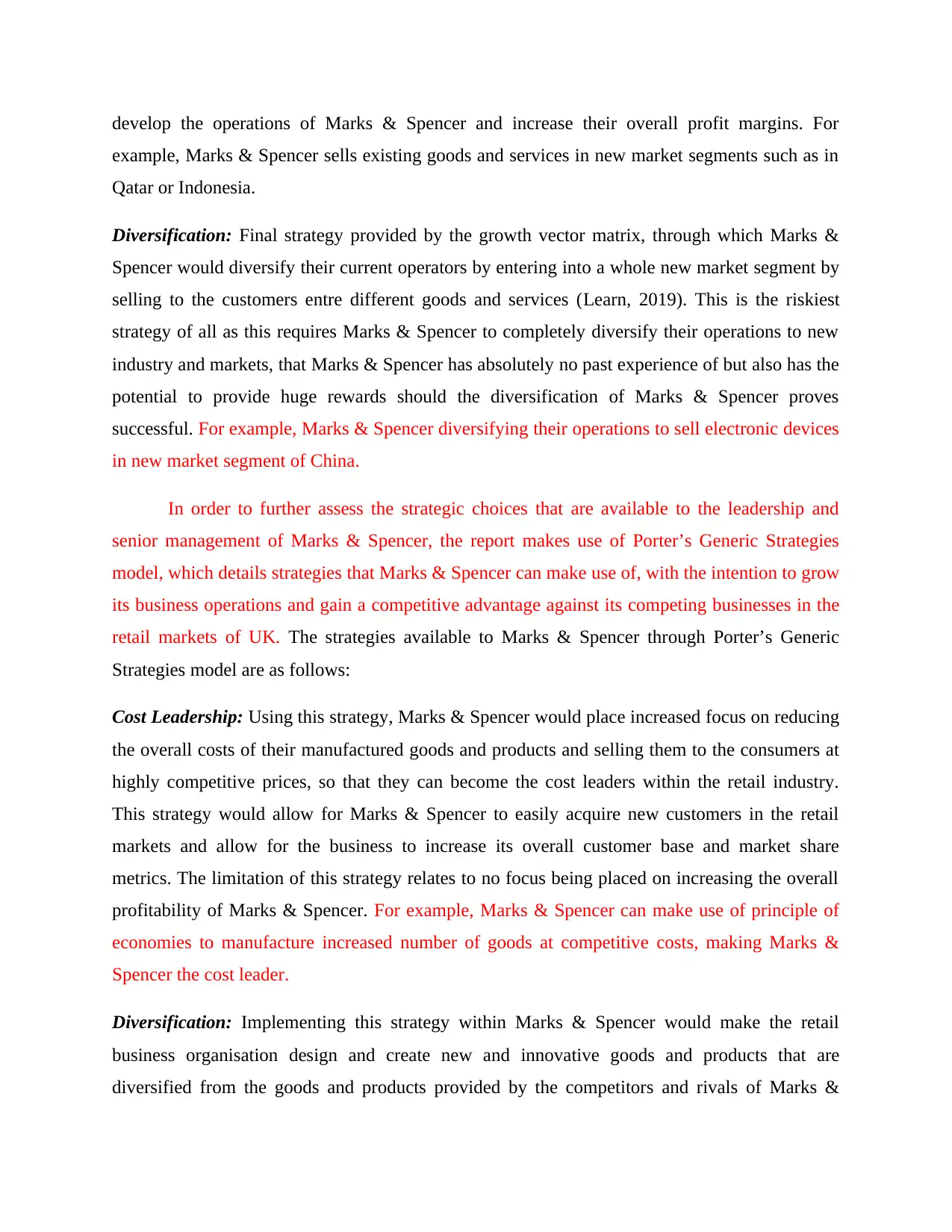
develop the operations of Marks & Spencer and increase their overall profit margins. For
example, Marks & Spencer sells existing goods and services in new market segments such as in
Qatar or Indonesia.
Diversification: Final strategy provided by the growth vector matrix, through which Marks &
Spencer would diversify their current operators by entering into a whole new market segment by
selling to the customers entre different goods and services (Learn, 2019). This is the riskiest
strategy of all as this requires Marks & Spencer to completely diversify their operations to new
industry and markets, that Marks & Spencer has absolutely no past experience of but also has the
potential to provide huge rewards should the diversification of Marks & Spencer proves
successful. For example, Marks & Spencer diversifying their operations to sell electronic devices
in new market segment of China.
In order to further assess the strategic choices that are available to the leadership and
senior management of Marks & Spencer, the report makes use of Porter’s Generic Strategies
model, which details strategies that Marks & Spencer can make use of, with the intention to grow
its business operations and gain a competitive advantage against its competing businesses in the
retail markets of UK. The strategies available to Marks & Spencer through Porter’s Generic
Strategies model are as follows:
Cost Leadership: Using this strategy, Marks & Spencer would place increased focus on reducing
the overall costs of their manufactured goods and products and selling them to the consumers at
highly competitive prices, so that they can become the cost leaders within the retail industry.
This strategy would allow for Marks & Spencer to easily acquire new customers in the retail
markets and allow for the business to increase its overall customer base and market share
metrics. The limitation of this strategy relates to no focus being placed on increasing the overall
profitability of Marks & Spencer. For example, Marks & Spencer can make use of principle of
economies to manufacture increased number of goods at competitive costs, making Marks &
Spencer the cost leader.
Diversification: Implementing this strategy within Marks & Spencer would make the retail
business organisation design and create new and innovative goods and products that are
diversified from the goods and products provided by the competitors and rivals of Marks &
example, Marks & Spencer sells existing goods and services in new market segments such as in
Qatar or Indonesia.
Diversification: Final strategy provided by the growth vector matrix, through which Marks &
Spencer would diversify their current operators by entering into a whole new market segment by
selling to the customers entre different goods and services (Learn, 2019). This is the riskiest
strategy of all as this requires Marks & Spencer to completely diversify their operations to new
industry and markets, that Marks & Spencer has absolutely no past experience of but also has the
potential to provide huge rewards should the diversification of Marks & Spencer proves
successful. For example, Marks & Spencer diversifying their operations to sell electronic devices
in new market segment of China.
In order to further assess the strategic choices that are available to the leadership and
senior management of Marks & Spencer, the report makes use of Porter’s Generic Strategies
model, which details strategies that Marks & Spencer can make use of, with the intention to grow
its business operations and gain a competitive advantage against its competing businesses in the
retail markets of UK. The strategies available to Marks & Spencer through Porter’s Generic
Strategies model are as follows:
Cost Leadership: Using this strategy, Marks & Spencer would place increased focus on reducing
the overall costs of their manufactured goods and products and selling them to the consumers at
highly competitive prices, so that they can become the cost leaders within the retail industry.
This strategy would allow for Marks & Spencer to easily acquire new customers in the retail
markets and allow for the business to increase its overall customer base and market share
metrics. The limitation of this strategy relates to no focus being placed on increasing the overall
profitability of Marks & Spencer. For example, Marks & Spencer can make use of principle of
economies to manufacture increased number of goods at competitive costs, making Marks &
Spencer the cost leader.
Diversification: Implementing this strategy within Marks & Spencer would make the retail
business organisation design and create new and innovative goods and products that are
diversified from the goods and products provided by the competitors and rivals of Marks &
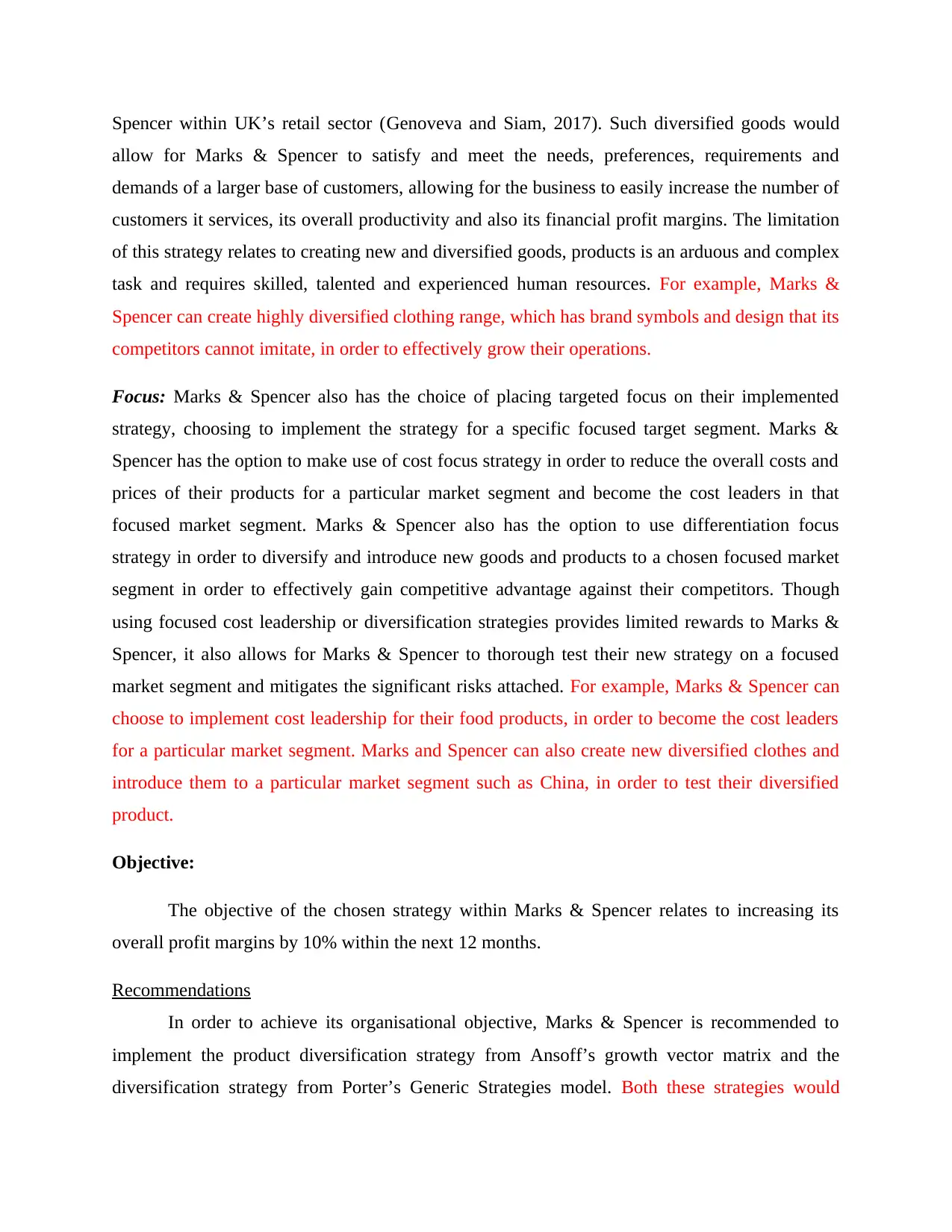
Spencer within UK’s retail sector (Genoveva and Siam, 2017). Such diversified goods would
allow for Marks & Spencer to satisfy and meet the needs, preferences, requirements and
demands of a larger base of customers, allowing for the business to easily increase the number of
customers it services, its overall productivity and also its financial profit margins. The limitation
of this strategy relates to creating new and diversified goods, products is an arduous and complex
task and requires skilled, talented and experienced human resources. For example, Marks &
Spencer can create highly diversified clothing range, which has brand symbols and design that its
competitors cannot imitate, in order to effectively grow their operations.
Focus: Marks & Spencer also has the choice of placing targeted focus on their implemented
strategy, choosing to implement the strategy for a specific focused target segment. Marks &
Spencer has the option to make use of cost focus strategy in order to reduce the overall costs and
prices of their products for a particular market segment and become the cost leaders in that
focused market segment. Marks & Spencer also has the option to use differentiation focus
strategy in order to diversify and introduce new goods and products to a chosen focused market
segment in order to effectively gain competitive advantage against their competitors. Though
using focused cost leadership or diversification strategies provides limited rewards to Marks &
Spencer, it also allows for Marks & Spencer to thorough test their new strategy on a focused
market segment and mitigates the significant risks attached. For example, Marks & Spencer can
choose to implement cost leadership for their food products, in order to become the cost leaders
for a particular market segment. Marks and Spencer can also create new diversified clothes and
introduce them to a particular market segment such as China, in order to test their diversified
product.
Objective:
The objective of the chosen strategy within Marks & Spencer relates to increasing its
overall profit margins by 10% within the next 12 months.
Recommendations
In order to achieve its organisational objective, Marks & Spencer is recommended to
implement the product diversification strategy from Ansoff’s growth vector matrix and the
diversification strategy from Porter’s Generic Strategies model. Both these strategies would
allow for Marks & Spencer to satisfy and meet the needs, preferences, requirements and
demands of a larger base of customers, allowing for the business to easily increase the number of
customers it services, its overall productivity and also its financial profit margins. The limitation
of this strategy relates to creating new and diversified goods, products is an arduous and complex
task and requires skilled, talented and experienced human resources. For example, Marks &
Spencer can create highly diversified clothing range, which has brand symbols and design that its
competitors cannot imitate, in order to effectively grow their operations.
Focus: Marks & Spencer also has the choice of placing targeted focus on their implemented
strategy, choosing to implement the strategy for a specific focused target segment. Marks &
Spencer has the option to make use of cost focus strategy in order to reduce the overall costs and
prices of their products for a particular market segment and become the cost leaders in that
focused market segment. Marks & Spencer also has the option to use differentiation focus
strategy in order to diversify and introduce new goods and products to a chosen focused market
segment in order to effectively gain competitive advantage against their competitors. Though
using focused cost leadership or diversification strategies provides limited rewards to Marks &
Spencer, it also allows for Marks & Spencer to thorough test their new strategy on a focused
market segment and mitigates the significant risks attached. For example, Marks & Spencer can
choose to implement cost leadership for their food products, in order to become the cost leaders
for a particular market segment. Marks and Spencer can also create new diversified clothes and
introduce them to a particular market segment such as China, in order to test their diversified
product.
Objective:
The objective of the chosen strategy within Marks & Spencer relates to increasing its
overall profit margins by 10% within the next 12 months.
Recommendations
In order to achieve its organisational objective, Marks & Spencer is recommended to
implement the product diversification strategy from Ansoff’s growth vector matrix and the
diversification strategy from Porter’s Generic Strategies model. Both these strategies would
⊘ This is a preview!⊘
Do you want full access?
Subscribe today to unlock all pages.

Trusted by 1+ million students worldwide
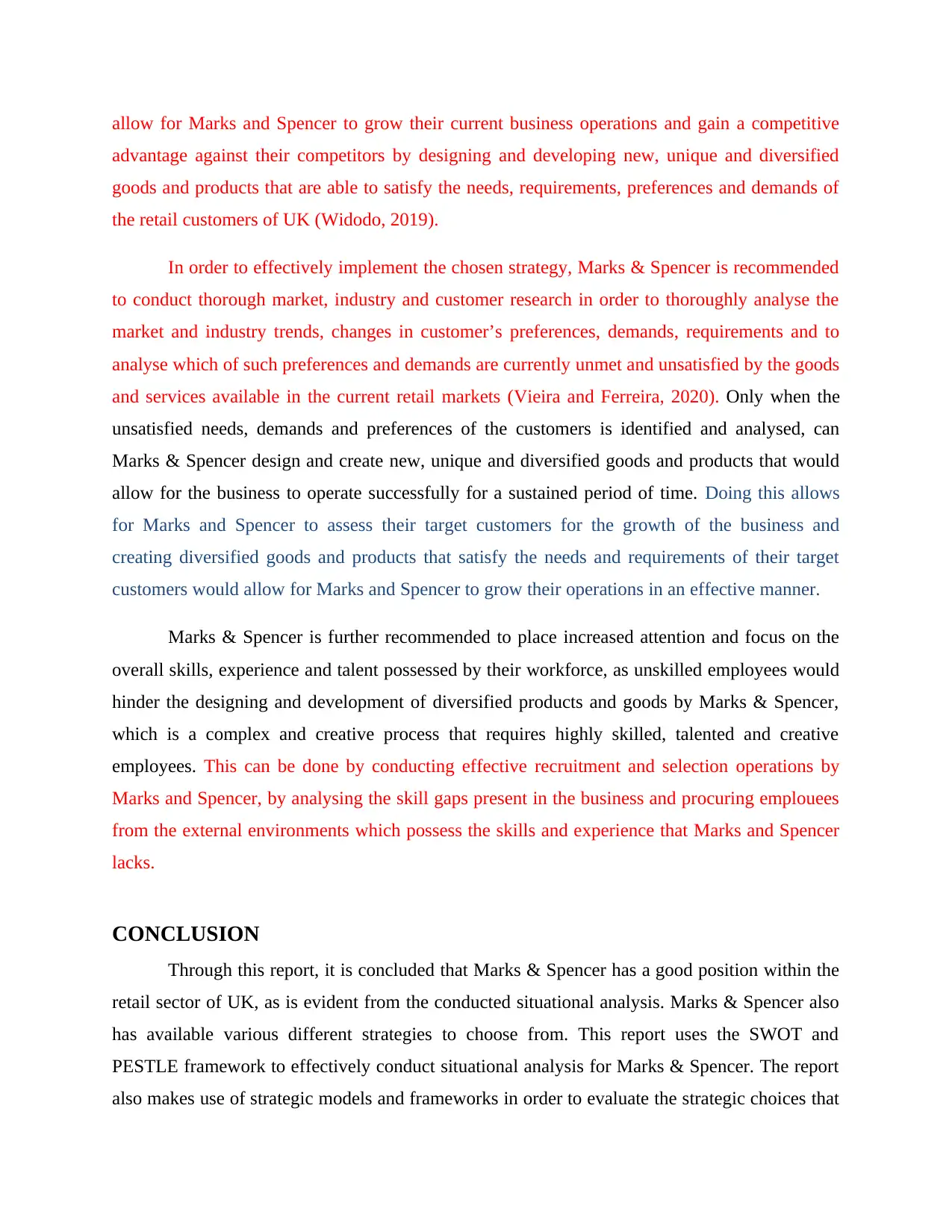
allow for Marks and Spencer to grow their current business operations and gain a competitive
advantage against their competitors by designing and developing new, unique and diversified
goods and products that are able to satisfy the needs, requirements, preferences and demands of
the retail customers of UK (Widodo, 2019).
In order to effectively implement the chosen strategy, Marks & Spencer is recommended
to conduct thorough market, industry and customer research in order to thoroughly analyse the
market and industry trends, changes in customer’s preferences, demands, requirements and to
analyse which of such preferences and demands are currently unmet and unsatisfied by the goods
and services available in the current retail markets (Vieira and Ferreira, 2020). Only when the
unsatisfied needs, demands and preferences of the customers is identified and analysed, can
Marks & Spencer design and create new, unique and diversified goods and products that would
allow for the business to operate successfully for a sustained period of time. Doing this allows
for Marks and Spencer to assess their target customers for the growth of the business and
creating diversified goods and products that satisfy the needs and requirements of their target
customers would allow for Marks and Spencer to grow their operations in an effective manner.
Marks & Spencer is further recommended to place increased attention and focus on the
overall skills, experience and talent possessed by their workforce, as unskilled employees would
hinder the designing and development of diversified products and goods by Marks & Spencer,
which is a complex and creative process that requires highly skilled, talented and creative
employees. This can be done by conducting effective recruitment and selection operations by
Marks and Spencer, by analysing the skill gaps present in the business and procuring emplouees
from the external environments which possess the skills and experience that Marks and Spencer
lacks.
CONCLUSION
Through this report, it is concluded that Marks & Spencer has a good position within the
retail sector of UK, as is evident from the conducted situational analysis. Marks & Spencer also
has available various different strategies to choose from. This report uses the SWOT and
PESTLE framework to effectively conduct situational analysis for Marks & Spencer. The report
also makes use of strategic models and frameworks in order to evaluate the strategic choices that
advantage against their competitors by designing and developing new, unique and diversified
goods and products that are able to satisfy the needs, requirements, preferences and demands of
the retail customers of UK (Widodo, 2019).
In order to effectively implement the chosen strategy, Marks & Spencer is recommended
to conduct thorough market, industry and customer research in order to thoroughly analyse the
market and industry trends, changes in customer’s preferences, demands, requirements and to
analyse which of such preferences and demands are currently unmet and unsatisfied by the goods
and services available in the current retail markets (Vieira and Ferreira, 2020). Only when the
unsatisfied needs, demands and preferences of the customers is identified and analysed, can
Marks & Spencer design and create new, unique and diversified goods and products that would
allow for the business to operate successfully for a sustained period of time. Doing this allows
for Marks and Spencer to assess their target customers for the growth of the business and
creating diversified goods and products that satisfy the needs and requirements of their target
customers would allow for Marks and Spencer to grow their operations in an effective manner.
Marks & Spencer is further recommended to place increased attention and focus on the
overall skills, experience and talent possessed by their workforce, as unskilled employees would
hinder the designing and development of diversified products and goods by Marks & Spencer,
which is a complex and creative process that requires highly skilled, talented and creative
employees. This can be done by conducting effective recruitment and selection operations by
Marks and Spencer, by analysing the skill gaps present in the business and procuring emplouees
from the external environments which possess the skills and experience that Marks and Spencer
lacks.
CONCLUSION
Through this report, it is concluded that Marks & Spencer has a good position within the
retail sector of UK, as is evident from the conducted situational analysis. Marks & Spencer also
has available various different strategies to choose from. This report uses the SWOT and
PESTLE framework to effectively conduct situational analysis for Marks & Spencer. The report
also makes use of strategic models and frameworks in order to evaluate the strategic choices that
Paraphrase This Document
Need a fresh take? Get an instant paraphrase of this document with our AI Paraphraser
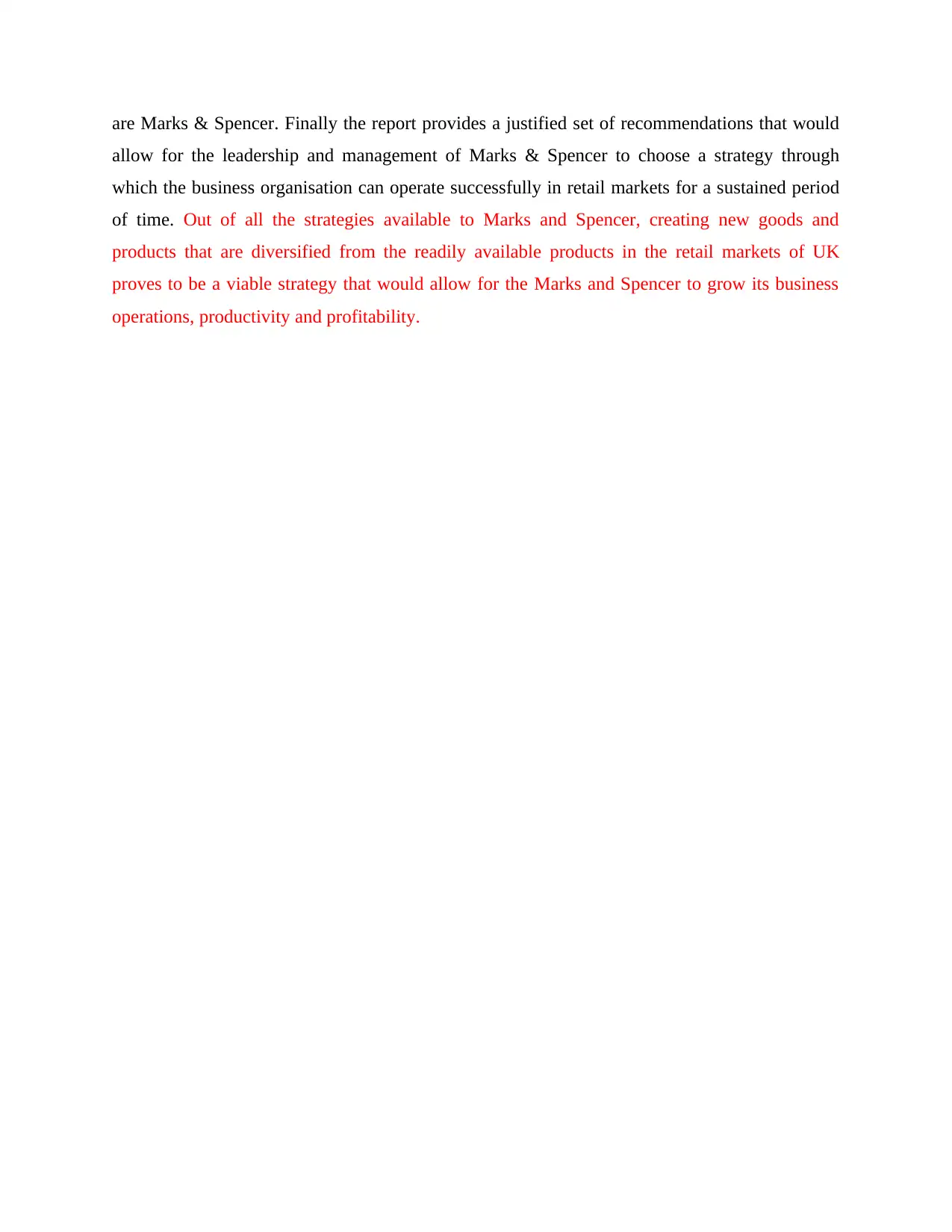
are Marks & Spencer. Finally the report provides a justified set of recommendations that would
allow for the leadership and management of Marks & Spencer to choose a strategy through
which the business organisation can operate successfully in retail markets for a sustained period
of time. Out of all the strategies available to Marks and Spencer, creating new goods and
products that are diversified from the readily available products in the retail markets of UK
proves to be a viable strategy that would allow for the Marks and Spencer to grow its business
operations, productivity and profitability.
allow for the leadership and management of Marks & Spencer to choose a strategy through
which the business organisation can operate successfully in retail markets for a sustained period
of time. Out of all the strategies available to Marks and Spencer, creating new goods and
products that are diversified from the readily available products in the retail markets of UK
proves to be a viable strategy that would allow for the Marks and Spencer to grow its business
operations, productivity and profitability.
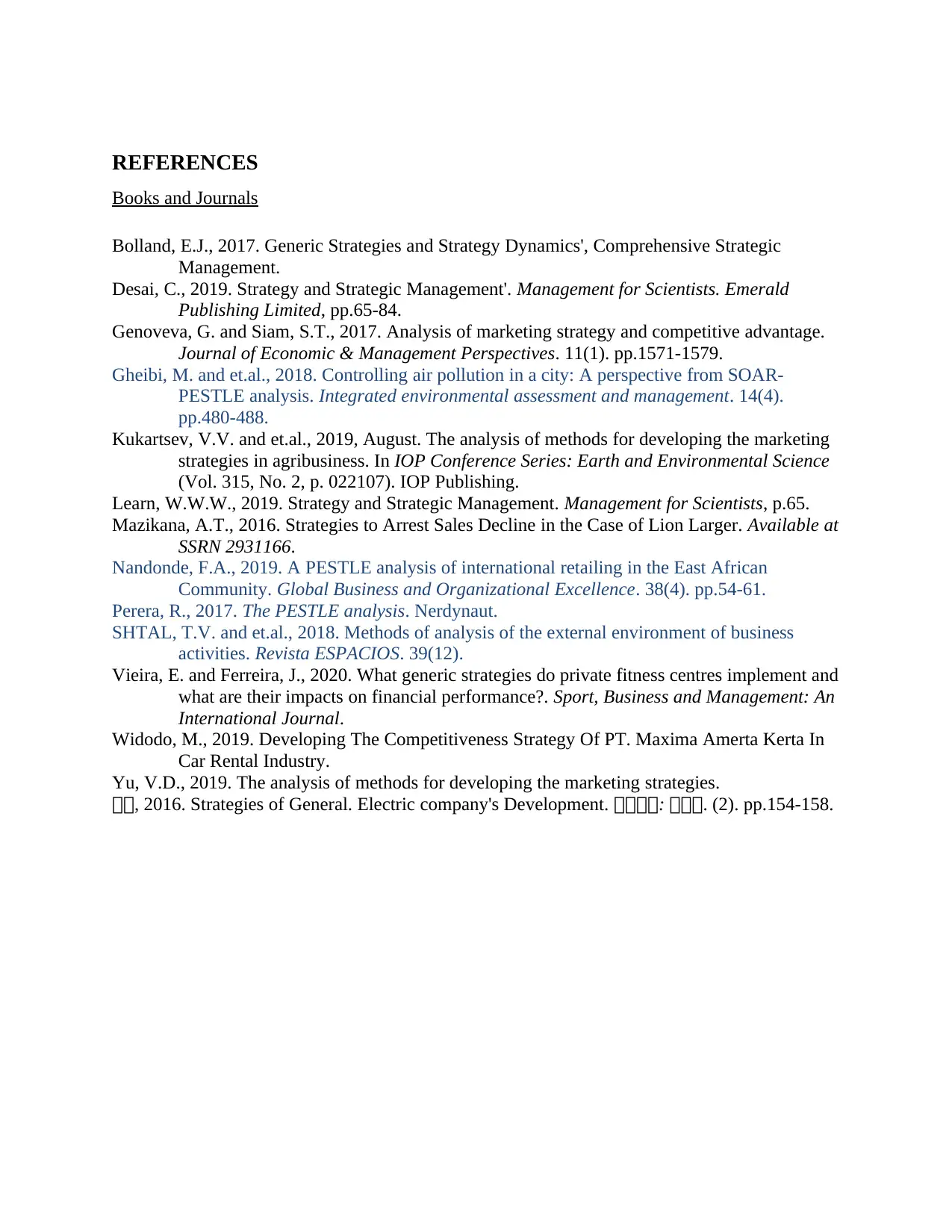
REFERENCES
Books and Journals
Bolland, E.J., 2017. Generic Strategies and Strategy Dynamics', Comprehensive Strategic
Management.
Desai, C., 2019. Strategy and Strategic Management'. Management for Scientists. Emerald
Publishing Limited, pp.65-84.
Genoveva, G. and Siam, S.T., 2017. Analysis of marketing strategy and competitive advantage.
Journal of Economic & Management Perspectives. 11(1). pp.1571-1579.
Gheibi, M. and et.al., 2018. Controlling air pollution in a city: A perspective from SOAR‐
PESTLE analysis. Integrated environmental assessment and management. 14(4).
pp.480-488.
Kukartsev, V.V. and et.al., 2019, August. The analysis of methods for developing the marketing
strategies in agribusiness. In IOP Conference Series: Earth and Environmental Science
(Vol. 315, No. 2, p. 022107). IOP Publishing.
Learn, W.W.W., 2019. Strategy and Strategic Management. Management for Scientists, p.65.
Mazikana, A.T., 2016. Strategies to Arrest Sales Decline in the Case of Lion Larger. Available at
SSRN 2931166.
Nandonde, F.A., 2019. A PESTLE analysis of international retailing in the East African
Community. Global Business and Organizational Excellence. 38(4). pp.54-61.
Perera, R., 2017. The PESTLE analysis. Nerdynaut.
SHTAL, T.V. and et.al., 2018. Methods of analysis of the external environment of business
activities. Revista ESPACIOS. 39(12).
Vieira, E. and Ferreira, J., 2020. What generic strategies do private fitness centres implement and
what are their impacts on financial performance?. Sport, Business and Management: An
International Journal.
Widodo, M., 2019. Developing The Competitiveness Strategy Of PT. Maxima Amerta Kerta In
Car Rental Industry.
Yu, V.D., 2019. The analysis of methods for developing the marketing strategies.
杨杨, 2016. Strategies of General. Electric company's Development. 时时时时: 学时时. (2). pp.154-158.
Books and Journals
Bolland, E.J., 2017. Generic Strategies and Strategy Dynamics', Comprehensive Strategic
Management.
Desai, C., 2019. Strategy and Strategic Management'. Management for Scientists. Emerald
Publishing Limited, pp.65-84.
Genoveva, G. and Siam, S.T., 2017. Analysis of marketing strategy and competitive advantage.
Journal of Economic & Management Perspectives. 11(1). pp.1571-1579.
Gheibi, M. and et.al., 2018. Controlling air pollution in a city: A perspective from SOAR‐
PESTLE analysis. Integrated environmental assessment and management. 14(4).
pp.480-488.
Kukartsev, V.V. and et.al., 2019, August. The analysis of methods for developing the marketing
strategies in agribusiness. In IOP Conference Series: Earth and Environmental Science
(Vol. 315, No. 2, p. 022107). IOP Publishing.
Learn, W.W.W., 2019. Strategy and Strategic Management. Management for Scientists, p.65.
Mazikana, A.T., 2016. Strategies to Arrest Sales Decline in the Case of Lion Larger. Available at
SSRN 2931166.
Nandonde, F.A., 2019. A PESTLE analysis of international retailing in the East African
Community. Global Business and Organizational Excellence. 38(4). pp.54-61.
Perera, R., 2017. The PESTLE analysis. Nerdynaut.
SHTAL, T.V. and et.al., 2018. Methods of analysis of the external environment of business
activities. Revista ESPACIOS. 39(12).
Vieira, E. and Ferreira, J., 2020. What generic strategies do private fitness centres implement and
what are their impacts on financial performance?. Sport, Business and Management: An
International Journal.
Widodo, M., 2019. Developing The Competitiveness Strategy Of PT. Maxima Amerta Kerta In
Car Rental Industry.
Yu, V.D., 2019. The analysis of methods for developing the marketing strategies.
杨杨, 2016. Strategies of General. Electric company's Development. 时时时时: 学时时. (2). pp.154-158.
⊘ This is a preview!⊘
Do you want full access?
Subscribe today to unlock all pages.

Trusted by 1+ million students worldwide
1 out of 12
Related Documents
Your All-in-One AI-Powered Toolkit for Academic Success.
+13062052269
info@desklib.com
Available 24*7 on WhatsApp / Email
![[object Object]](/_next/static/media/star-bottom.7253800d.svg)
Unlock your academic potential
Copyright © 2020–2025 A2Z Services. All Rights Reserved. Developed and managed by ZUCOL.





